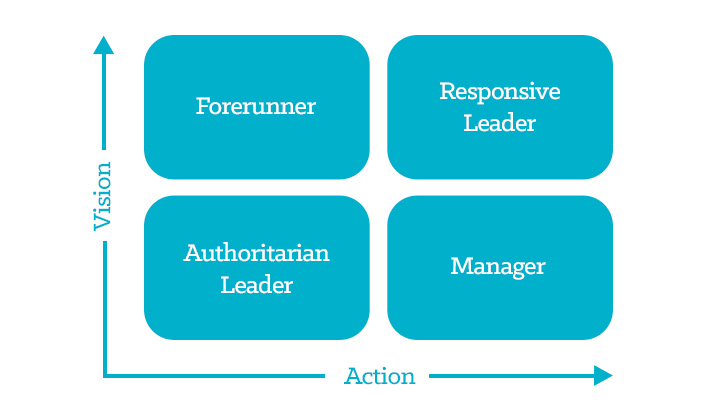Some experts will say that they can solve the problems you face within a changing industry, but the best way your destination marketing organization can adapt is through responsive leadership from within. Frank Cuypers, Senior Strategic Consultant for Destination Think, explains four types of leadership.
If you’ve attended enough marketing conferences, there’s a good chance that you’ve heard a guru or consultant explain the boiling frog anecdote. The story goes like this: If you drop a frog in a pot of boiling water, it will immediately jump out. But if you start with a pot of cold water and increase the temperature gradually, the frog will stay in the pot until it boils alive. Gurus use this tale to create urgency (for their services) and illustrate that ignoring signals of change can cause organizations to fail. How can a DMO effectively adapt to change and avoid failure over the long term? It starts by defining effective leadership within an organization.
One important reason for failure in leadership is the continuing confusion over situational and formal roles. Situational roles change with the needs of the current circumstances and projects while formal roles represent official job titles. Confusion can occur when line managers overrule project leaders, or when technical experts are forced to take management roles, or when executives feel the urge to micromanage.
The best leadership cannot rely on a single individual. In times of disruption (which is quite possibly all the time), leading a company toward lasting success means guiding and navigating with a clear vision for the future as well as a clear path to achieving goals along the way. Understanding strengths within a team and using them cohesively will help generate clarity of purpose and execution.
Four types of leadership are common within DMOs and other organizations:
Authoritarian
Authoritarian leaders use formal or legal power to justify their actions. Their signature becomes a unilateral reason for any decision they make on behalf of the organization. Authoritarian leadership doesn’t aim for support within the organization, nor does it present a vision or method of implementing the vision. Often, this kind of leadership can be summed up with the phrase: “Do this because I say so.” The result? Siloed management and a culture of obedience. With any luck, this type of leadership is declining.
Manager
A manager is an expert in planning and organizing tasks. They are able to promote team bonding and have a healthy perspective on what efforts should be made in order to achieve the best results. That said, why these results are important is secondary here, and this can lead to an organization fully driven by management tools, measurement systems, scorecards, spreadsheets, evaluations and procedures.

Forerunner
The forerunner is a leader with a strong vision for the organization as a whole. Forerunners know exactly how to inspire people by defining what results to achieve and why. These leaders often give direction but forget to provide a path to follow. Nothing cripples a company faster than a CEO who bombards his colleagues with ideas at the slightest provocation. These ideas might come from anywhere: their own imagination or from the last convention they attended (where they learned about the urgency of the boiling frog). Important processes, projects and roles are swept into one big pile with one simple directive: “We urgently need to do this.”
Responsive Leadership
Responsive leadership occurs when the organizational structure determines a leader based on the current project or challenge. It adapts to the needs of the task at hand, just as a good website adapts to the device the audience is using. It creates an organizational structure that focuses mainly on people and trust. This organization will only need a couple of standard procedures because of the strong consensus about the goals and methods to achieve them. The team can then channel its energy into providing value for those it serves. For a DMO, this creates a consumer-driven culture. When customer centricity becomes part of the vision, responsive leadership reinforces it, as the members respond to new challenges for the industry or the destination. Leadership roles within these organizations are self-chosen and there is no hierarchy.
Choose the Responsive Model
Do you currently have a leadership role? As Socrates would say, “knowing that you know nothing” is an important skill to master. Ask your peers questions to improve your knowledge and include your whole team. Look beyond the typical sources of information and refuse to rely solely on arguments based on reports from your departments.
If your aim is to create an organization that’s flexible and ready for the future, choose the responsive model. Give your employees as much trust as you can, until it feels uncomfortable. Everyone needs the opportunity to express his or her ideas within the team. Only this collective power can lead to a fresh approach in times where innovation is the key to lasting success.
As one of the most important leaders of the twentieth century, Dr. Martin Luther King Jr., had a clear vision for change. He knew exactly how to get people moving when he said: “Faith is taking the first step, even when you don’t see the whole staircase.”
Related reading on leadership: A destination marketer’s guide to strategic leadership
Related reading on industry collaboration: Design thinking for the modern DMO
Is the vision for your destination shifting? The destination marketing industry discussed their greatest challenges at Destination Think Forum 2016. Download the “Leading your destination into the future” whitepaper for strategic insights on the role of the DMO.










0 Comments